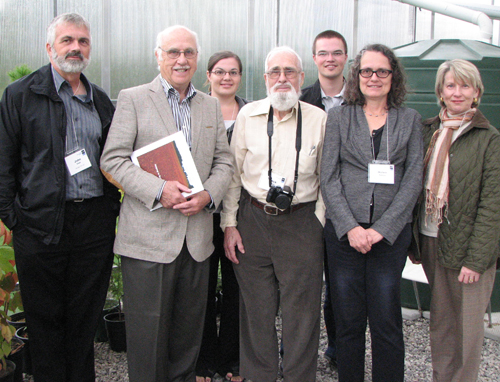
A dedication ceremony was held Sept. 27 to name a new greenhouse in memory of one of the Arboretum’s best-known horticulturalists, Henry Kock, who died in 2005. Friends, family and colleagues gathered to remember the man whose legacy will live on in the plants that grow in the greenhouse bearing his name.
Philip and Susan Gosling of the Gosling Foundation donated $250,000 toward the greenhouse. Although such gifts to the University are usually named for the donors, the Goslings wanted to honour Kock, and the Henry Kock Propagation Centre was born.
“I am truly pleased that this much-needed and long-awaited greenhouse is now built and ready for growing,” said Philip Gosling. “The naming of the greenhouse gave the foundation the opportunity to remember Henry, and particularly, the important role he played in preserving native species, which always appealed to us.”
Kock’s sister, Helen Rykens, said his passion for nature began in his youth, when he would scatter the seeds of native plants to create natural gardens. He studied environmental horticulture at U of G, graduated in 1977 and joined the Arboretum in 1982 as a plant propagator, later becoming an interpretive horticulturalist.
Protecting American elm trees from the ravages of Dutch elm disease became Kock’s mission when he discovered that some trees appeared to be resistant to the disease. He established the Elm Recovery Project to create a seed orchard and cultivate disease-resistant trees.
U of G president Alastair Summerlee said the project was Kock’s “most remarkable legacy,” adding that the greenhouse is one of many initiatives that will make the planet a better place to live as part of the University’s BetterPlanet Project.
“The greenhouse is the heart of the Arboretum,” added director Alan Watson. “This is where everything begins. This is where we grow plants from seeds; this is where we nurture them and move them out into the collections.”
Construction of the 3,600 square-foot facility coincided with the Arboretum’s 40th anniversary. The new greenhouse will provide educational, research and outreach opportunities for students, staff and faculty. The building features exterior walls made of corrugated plastic, a roof with vents that open and close, a shade/heat retention cloth and rain barrels.
Previously, the Goslings established the Arboretum’s popular Gosling Wildlife Gardens to teach the public how to transform their own backyards into wildlife habitats.